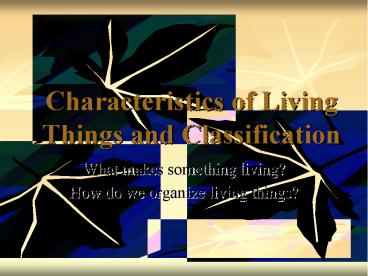Characteristics of Living Things and Classification - PowerPoint PPT Presentation
Title:
Characteristics of Living Things and Classification
Description:
Title: Characteristics of Living Things and Classification Author: Kenton Last modified by: Kenton Created Date: 9/23/2004 2:34:46 PM Document presentation format – PowerPoint PPT presentation
Number of Views:288
Avg rating:3.0/5.0
Title: Characteristics of Living Things and Classification
1
Characteristics of Living Things and
Classification
- What makes something living?
- How do we organize living things?
2
Biology
- Bio- life
- Ology- study of
What are they looking at?
3
BIOLOGY THE STUDY OF LIFE.
- ALIVE OR NOT ALIVE????
- Scientists have not really decided upon a single
definition of life, but it is determined by the
actions of life functions carried on by an
organism.
Click for biology song http//www.youtube.com/wat
ch?vaynclw6TXeEfeaturerelated
4
I. Organization of Living Things
MULTICELLULAR ORGANISMS
COMPLEX
UNICELLULAR ORGANISMS
SIMPLE
5
II. 4 Characteristics of ALL Living Things
- Living things are made of CELLS that contain DNA
- Living things have a METABOLISM to help them use
ENERGY to live, grow, and develop - Living things maintain HOMEOSTASIS (a stable
internal environment) - Living things REPRODUCE
6
Characteristics of Living Things(531)
7
III. Similarities and Differences Among Living
Things
- Living things go about the 4 characteristics in
similar AND different ways - 8 Life processes that are similar and different
among living things - Obtaining nutrients
- Transport of materials throughout organism
- Breaking down nutrients to get energy (cellular
respiration) - Combining simple substances to make more complex
substances (synthesis) - Growth
- Removal of waste products (Excretion)
- Responding to internal and external stimuli
- Reproducing
8
Simple to Complex (153)
9
IV. Helping Vocabulary
- Number of cells
- Multicellular
- Made of many cells
- Examples Plant, Animals
- Unicellular
- Made of one cell
- ex. Bacteria, Paramecium, Ameba, Euglena, Yeast
Copy down all of the examples
10
- B. Nucleus?
- Eukaryote
- Cells contain a nucleus
- Prokaryote
- Cells lack a nucleus
- C. Mode of nutrition
- Heterotroph
- Need to obtain food ex. humans
- Autotroph
- Can make their own food by a process called
photosynthesis ex. plants
11
The Five Kingdoms (352)
12
(No Transcript)
13
The 5 Kingdoms
- Similarities and Differences in life processes
has grouped organisms into 5 different kingdoms - Animalia
- Fungi
- Plantae
- Protista
- Monera
MULTICELLULAR
EUKARYOTIC
UNICELLULAR
PROKARYOTIC
14
V. Obtaining Nutrients (FOOD!?)
- Heterotroph
- Gets nutrients from the environment
- Kingdoms
- Animalia, Fungi, Some Protista and Monera
- Autotroph
- Makes own food
- Kingdoms
- Plantae and some Protists (photosynthesis), some
Bacteria (chemosynthesis)
15
Quiz Time
- What does prokaryote mean?
- Give an example of a prokaryote.
- What does autotroph mean?
- Give an example of an autotroph.
- Name 3 of the 5 Kingdoms.
- What does the nucleus of a cell hold?
16
VII. Transport of materials
- Unicellular Orgs
- Transport within cytoplasm
- Kingdoms
- Protista, Monera
- Multicellular Orgs
- Transport within liquids and tubes
- Kingdoms
- Animalia, Plantae, Fungi
17
VIII. Reproduction
- Asexual
- One parent
- Offspring genetically identical (clones)
- Kingdoms
- Some Fungi, Protista, Monera
- Sexual
- Two parents
- Offspring genetically different from parents
- Kingdoms
- Some Fungi, Plantae, Animalia
18
IX Classification of Living Things
- Why classify organisms?
- For easy identification
- For evolutionary comparison of organisms
- Organisms are grouped into large categories based
on similarities - Once in a group, organisms are separated based on
differences
Modern Classification System classify from
broad to specific
19
Classification of Living Things
- 5 Kingdoms
- Phyla (s. Phylum)
- Class
- Order
- Family
- Genus
- Species
DIVIDED INTO
DIVIDED INTO
DIVIDED INTO
OF ORGANISMS DECREASES
DIFFERENCES AMONG ORGS INCREASES
DIVIDED INTO
DIVIDED INTO
DIVIDED INTO
20
Acronym to help remember!
- King
- Phillip
- Called
- Oprah
- For
- Good
- Spices
21
Classification of Humans
- KINGDOM Animalia
- PHYLUM Chordata
- Has backbone
- CLASS Mammalia
- Females have mammary glands
- ORDER Primates
- Larger brain size
- FAMILY Hominidae
- GENUS Homo
- SPECIES sapiens
22
Scientific Naming
- Referred to as Binomial Nomenclature (2 name
naming system) - Scientific name Genus species
- species is not capitalized
- Both are always italicized or underlined
- Ex. Homo sapiens or Homo sapiens
- Abbreviation
- First letter of genus (capitalized), followed by
species - Ex. H. sapiens
- Scientists have only identified and named a
FRACTION of all living organisms on Earth!!!!
23
Canis lupus grey wolf































